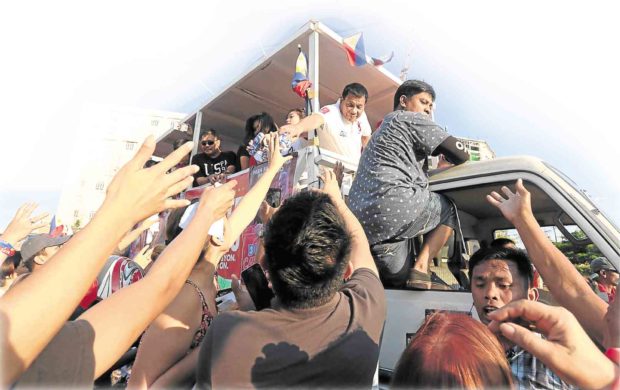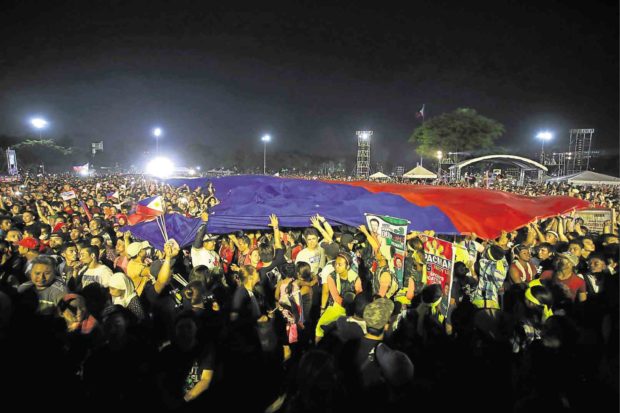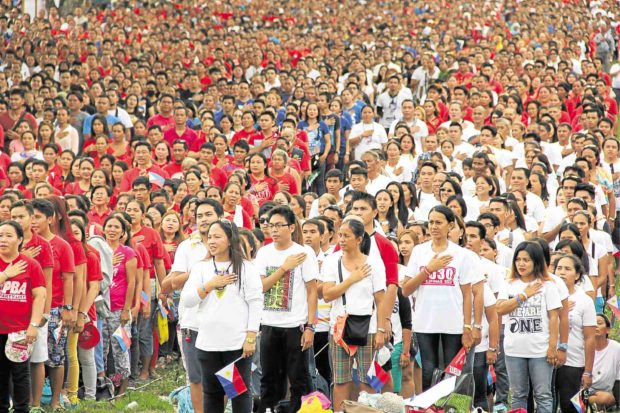‘From the masses, to the masses’

PEOPLE watching a motorcade of Duterte pass by in Pasay City reach out to the now presumptive President-elect as he hands out bottles of water and tries to shake the hands of spectators. GRIG C. MONTEGRANDE
THE ANSWERS to how the unconventional campaign of Rodrigo Duterte was able to soundly defeat the supposedly tried and tested formulas of his rivals could be as elusive as the man who is being credited by his grassroots workers with Duterte’s victory—former rebel priest Leoncio Evasco.
But while Evasco has successfully evaded packs of reporters hungry for answers to how he did it, one of his leaders on the ground in the Mindanao campaign has given Inquirer a glimpse of what made the Duterte campaign click.
According to Joselito “Penpen” Libres, also a former rebel like Evasco, there was no complicated strategy in the campaign. It was simply a mass movement for change, he said.
This may explain why one of Duterte’s favorite lines is “gikan sa masa, para sa masa (from the masses, to the masses),” lifted from a quote by Chinese revolutionary leader Mao Zedong and which Duterte used as the title of his weekly TV program in the city.
According to Libres, grassroots leaders of the Duterte campaign, especially in Mindanao, believed that the people wanted change and saw it was possible through Duterte. It was a belief in the people’s capacity to bring about change when the chance to do it, in this case the elections, presented itself.
Article continues after this advertisement“The principal strategy was to push for a campaign that relies on mass movement,” said Libres, one of the prime movers of the Duterte campaign in Mindanao.
Article continues after this advertisementLeft strategy

SUPPORTERS of Duterte pass around an oversized Philippine flag to symbolize unity during the last campaign rally of the now presumptive President at the Quirino Grandstand in Luneta. MARIANNE BERMUDEZ
Libres said it was a three-step strategy—inform, organize and mobilize. It sounds like a classic leftist strategy. And it is.
Libres said the campaign team was composed mainly of former leftist activists who bravely fought the Marcos dictatorship.
He said former cadres, who went underground during the dark days of martial law, composed the core of Duterte’s campaign team in Mindanao.
“Many of the members of the campaign have activist backgrounds,” Libres said.
Evasco is known to Duterte not just as a former rebel priest. He was city administrator under Duterte and later, mayor of Maribojoc town, Bohol province which he governed with the same grit and toughness with which Duterte governed Davao City.
“In the grassroots level, there were many former activists, who now work in government, NGOs and private businesses, who were involved in the campaign,” Libres told Inquirer.
He said many former activists, who surfaced after the fall of the Marcos dictatorship and supported Duterte, kept communication lines open with former comrades who were still in the armed struggle.
The main advantage of a campaign run by former cadres and activists, according to Libres, was it gave the campaign a grassroots touch and helped build a foundation that would be uncompromising on principles and a pro-poor agenda.
Bottom-to-top

THOUSANDS of Duterte supporters gather at the Crocodile Park in Davao City and sing the national anthem during a rally for the incoming leader on May 7. BARRY OHAYLAN/CONTRIBUTOR
“In the beginning, the primary task was to build the mass movement while the other aspect of alliance work with other parties and candidates was pursued in the middle or latter part of the campaign,” Libres said.
It was an inverted pyramid formula, bottom-to-top strategy and it was a big gamble, Libres said. It was unconventional, he said.
“Duterte had no established, well-oiled mechanism unlike the other (candidates) who are already set from the top to the bottom,” Libres said.
“He needed to adjust his approaches because the traditional method was not appropriate,” he said.
Libres said the conventional way of dealing with political parties and politicians would have been through money.
“They would usually ask how much they would get,” Libres said. “The mayor does not have the money and would also not engage in financial horse trading even if he has the resources.”
“So our approach was, when we had built up the mass movement and support for Duterte, we used this as a bargaining chip in talking with parties and candidates,” he said.
It was common for candidates to use personal and party resources to gain advantage in their campaigns, Libres said.
“But Duterte’s campaign proved that you do not need to have the money and a strong political party to win,” he said. “For his campaign, the people filled the gap in resources,” Libres added.
Instead of shelling out cash to pay for campaign workers, the Duterte campaign tapped volunteers who offered their services for free and were given tasks ranging from actual campaigning to printing T-shirts and campaign materials.
“Ordinary people even volunteered to provide the materials that we needed,” Libres said.
Testing the waters
When Duterte started his listening tours for federalism last year, which his campaign team admitted aimed to test the waters for the Davao mayor and his chances of winning the presidential race, Libres said the crowds and audiences the presumptive President attracted were small.
Libres said the campaign team was aware that Duterte’s popularity was low before his listening tours since few people knew him outside of Mindanao.
Duterte’s most memorable appearance on national TV was his attendance at a Senate inquiry on rice smuggling in February 2014 during which he publicly cursed and threatened to kill a businessman accused of bringing in smuggled rice through Davao City.
The crowds attending Duterte’s listening tours swelled by the thousands soon after.
“We can trace this overwhelming support to the desperation of people for real change,” Libres said.
Duterte’s main platform was crafted based on his conversations with people during his tours around the country, the campaign team said.
This mass movement that helped propel Duterte to the highest elective position of the land would keep itself intact and continue to grow, said Libres.
“It was clear from the start that the burning desire was not just to generate votes but also to protect their votes,” Libres said.
Libres said with Duterte starting the transition to his administration, his Mindanao campaign team wished the people would own the victory, own the government.
Grassroots governance
“Our agreement (among members of the Mindanao campaign team) was to sustain the movement,” said Libres.
“This movement that got Duterte elected will be the same movement that will support him in realizing his objectives,” Libres said.
He said Duterte now had promises to fulfill and the unconventional campaign machinery that helped him win would be transformed into one big watchdog that would take part in governance in the grassroots level.
“They will be involved in various programs and projects,” said Libres. “They should feel that they have a role in this government. The people will be involved even in simple undertakings like education, information dissemination and suppressing criminality.”
“This mass movement will also act as a watchdog to check on the performance of agencies, local government units and even Malacañang. The people will play an active role. They are not just recipients of government programs,” he added.